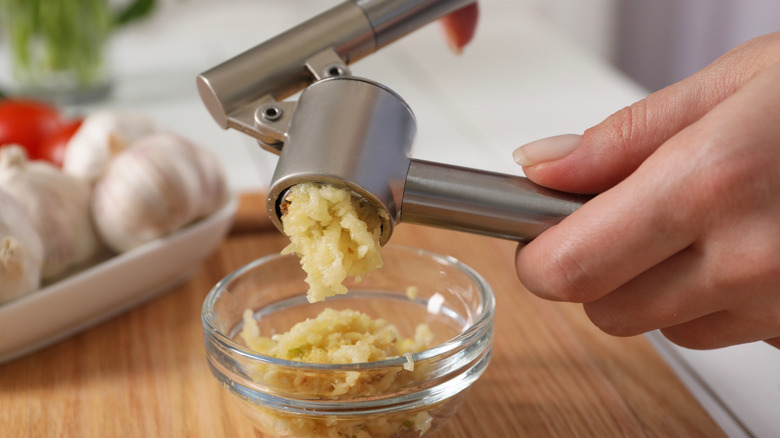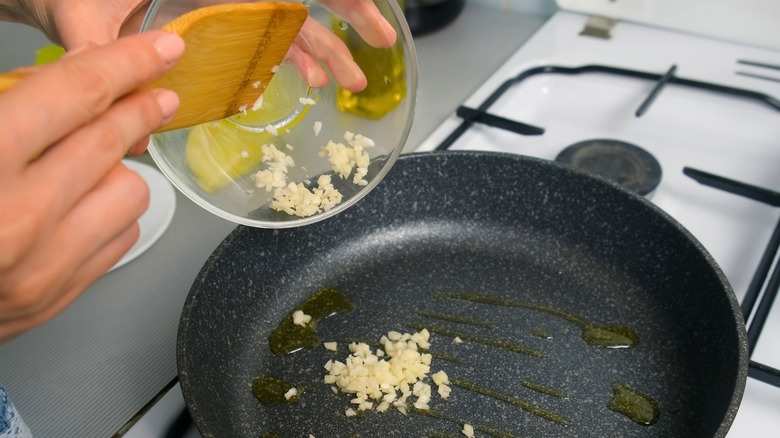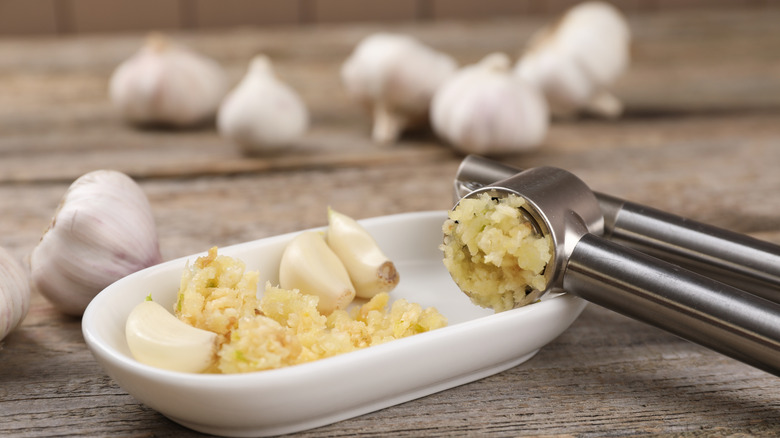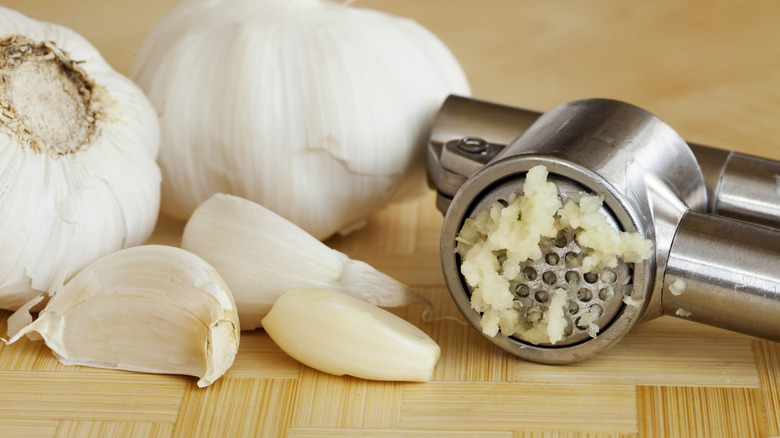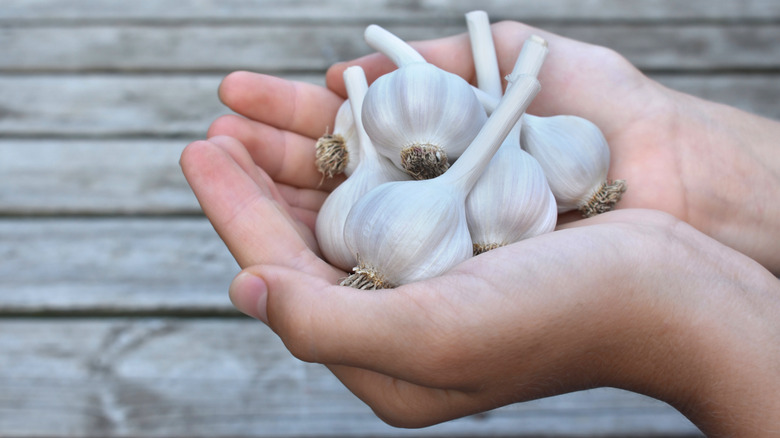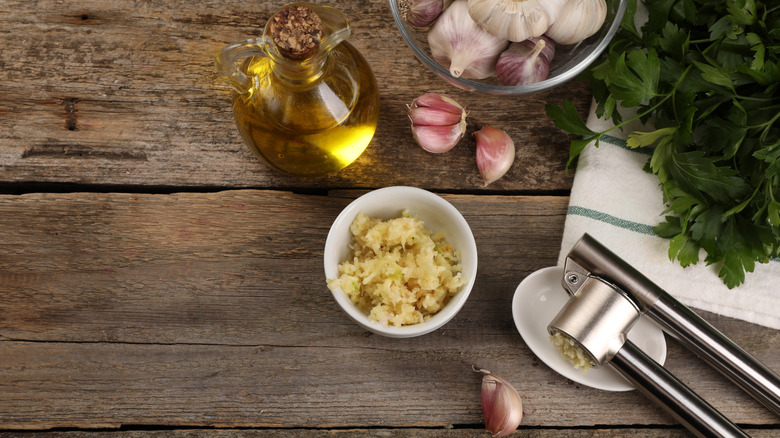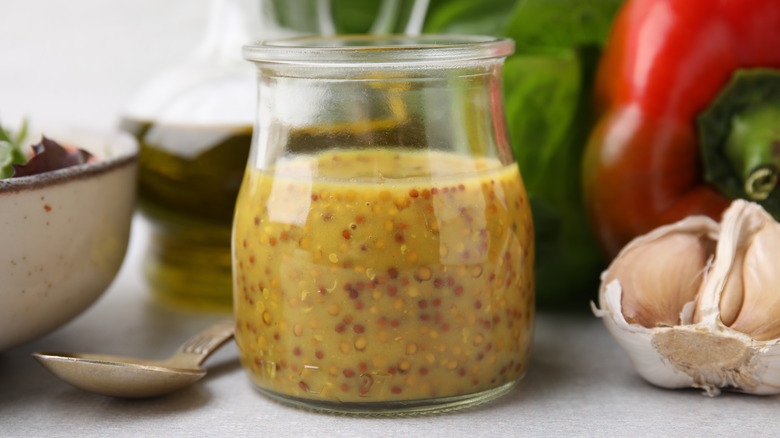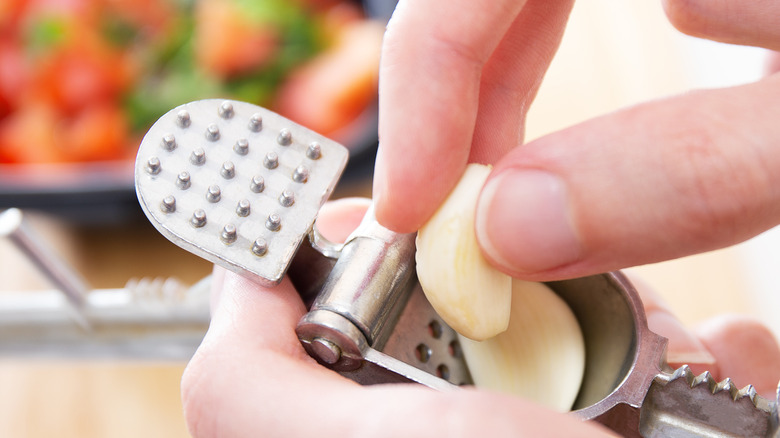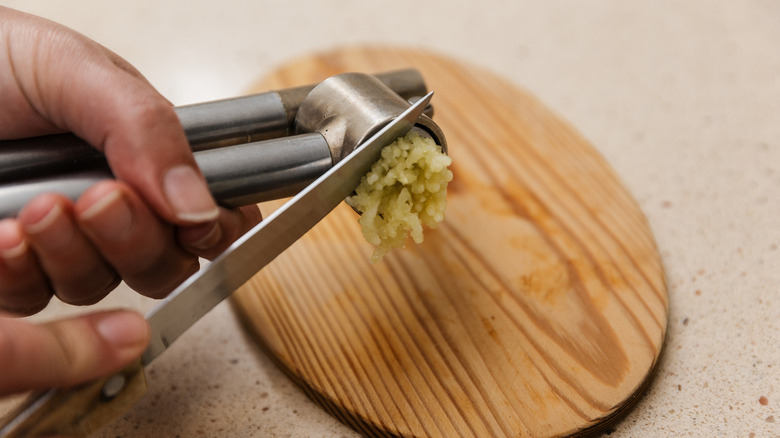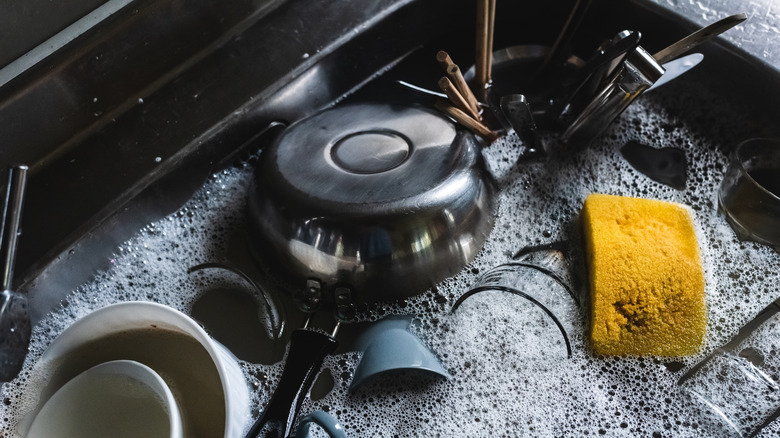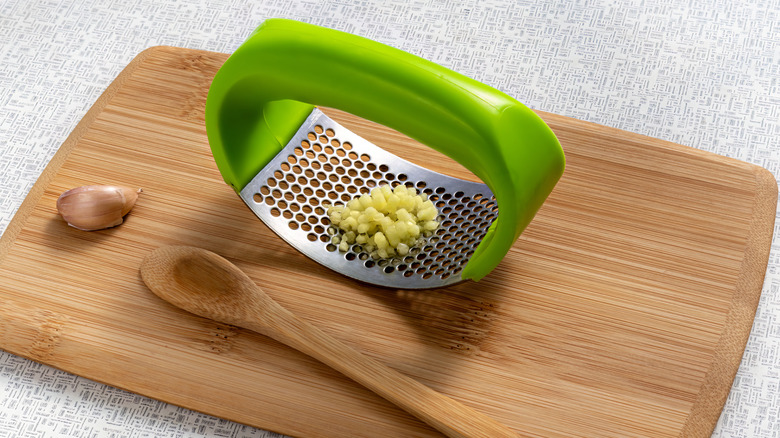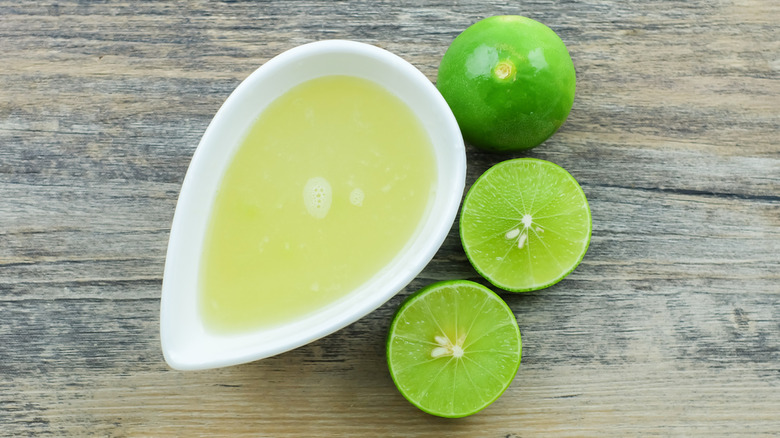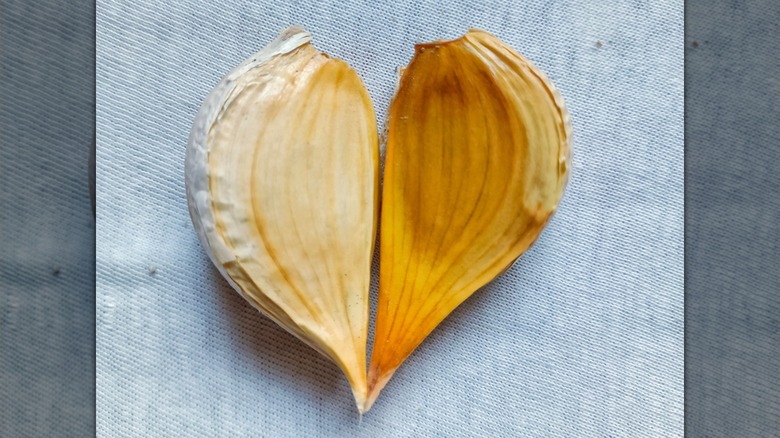Avoid These 12 Mistakes When Using Your Garlic Press
The garlic press has a bit of a PR problem. Chefs love to hate it. Just get a knife, they argue. They'll tell you a garlic press is a pain to clean, turns garlic into a fire-breathing dragon, and is just another single-use gadget cluttering your already jam-packed kitchen drawers.
But you know what? Garlic press lovers might actually be the silent majority, quietly squeezing cloves while the critics are yelling at the garlic goo stuck on their cutting boards. Turns out that many of the complaints about garlic presses boil down to a few easy-to-avoid mistakes.
Hard to clean? It might be a mistake to skip the olive oil. Too garlicky? It might just be the wrong place and time. Single-use gadget? Not even close. It's a big mistake to assume this kitchen tool is only useful for garlic. Whether you're already team garlic press or just a little curious, let's press on to learn about some common mistakes to avoid.
1. Using the wrong tool for the recipe
Don't press your luck! Make sure you're using the right tool for the right recipe. Just because you have a garlic press doesn't mean you should always use it. Yes, a garlic press is a fantastic time-saver. But in the wrong context, it can ruin your dish. Pressed garlic is more intense, releasing more juice and oils, which means it cooks and burns faster. In a quick sauté or stir fry, that garlic can go from golden to burnt and bitter in seconds. If your recipe calls for chopped garlic in a hot pan, put the garlic press down. Grab a knife instead.
Texture and flavor intensity also matter. Some dishes with few ingredients won't work well with pressed garlic. Take a simple spaghetti aglio e olio — sliced garlic infuses the oil subtly while adding a bit of texture. Swap that out for pressed garlic, and suddenly the dish is overpowered with spicy garlic. The same goes for light sauces — don't attack them with pressed garlic. For a sauce needing a mild garlic flavor, chopped garlic will work better than pressed.
But when you're ready for a powerful and even garlic flavor throughout a dish, definitely grab that garlic press. It's great for raw applications like salad dressings, mayonnaise, aioli, hummus, and pesto. Pressed garlic also works well for slow-cooked dishes like chili or stew. After a long simmer, you'll get a deep yet mellow garlic flavor that's just right.
2. Pressing too much garlic
Recipes usually tell you how much garlic to use, and how to prep it. But if you're tweaking things to taste, not using a recipe, or maybe creating your own, proceed with caution. Pressed garlic doesn't mess around. It produces a very strong flavor, so you might need less than you think.
When you press, crush, or mince garlic, you open tons of tiny cell walls. This releases allicin, which gives garlic its powerful flavor and aroma (it's also why that smell clings to your fingers no matter how much you scrub). If you just slice garlic into big pieces, you only break a few cell walls — less allicin and a milder garlic taste.
This all means a whole, unbroken clove equals a mild garlic flavor. Sliced garlic equals a medium garlic flavor. Minced garlic equals a strong flavor. And pressed garlic equals garlic with a capital G. The difference is striking — one pressed clove can release more flavor than a dozen cooked whole cloves! So, if you're using a garlic press, consider easing up a bit. Don't let the convenience of a press overpower the flavor of your dish.
3. Knowing when to peel and when not to
To peel or not to peel? That is the question — and your garlic press might already have the answer. Defer to the manufacturer's recommendations. Many presses are designed to handle unpeeled cloves. Just pop the garlic in, skin and all, give it a good squeeze, and let the tool do its magic. Open up the press to find an empty skin that you simply remove, making cleanup a breeze.
But there may be some occasions where it's worth peeling the garlic beforehand, even if your press claims it can handle unpeeled cloves. Sometimes, pressing unpeeled cloves can take a bit more oomph. If you're working with a lot of garlic or don't have the grip strength of a professional rock climber, peeling can make pressing a lot easier.
Even if you skip peeling, it's a good idea to remove any loose skin before pressing. It helps prevent clogging, so every last bit of garlicky goodness makes it through the press.
4. Using the wrong garlic
The right tool is useless with the wrong garlic. If you want the best results, start with fresh cloves. Look for bulbs that are firm to the touch, with tight, unbroken skins. If it feels surprisingly heavy for its size, that's a good thing. It means it's juicy and full of flavor. If you see a bulb that's sprouting green shoots, leave it behind at the store. If your garlic decides to sprout after you've already brought it home, it's still safe to eat. Just remove the green sprout before pressing. Keep in mind, though, sprouted garlic is older and less flavorful.
When it comes to mashing bananas for banana bread, we're quick to choose the mushy, brown-spotted ones. Don't use the same strategy for pressing garlic! You can tell garlic has gone bad if it's mushy or has brown spots. Putting bad garlic through a press won't save it. Instead, it might ruin your dish. Brown and mushy only works for bananas.
Opting for fresh cloves is an easy choice, but you might run into harder decisions if you consider the many varieties of garlic. Most grocery stores sell softneck garlic, which has a long shelf life and lots of small cloves. At farmers' markets, you might find hardneck garlic. This variety usually has fewer, larger cloves and a shorter shelf life. But many cooks enjoy hardneck garlic for its more complex and robust flavor. If you're into experimenting, it's worth a try.
5. Skipping the olive oil or cooking spray
There's a simple tip to make using your garlic press even easier — cooking oil! Before you add your cloves, spray just a tad of olive oil into the empty chamber of your garlic press (spritz over the sink for less mess). If you don't have olive oil spray, you can also just use your finger to dab a bit of olive oil onto your press. Avocado oil, canola oil, or another neutral oil with little or no flavor will also work just fine.
Once you've created slippery conditions in your garlic press, add your peeled or unpeeled cloves, and press away. Rest assured, the oil won't mess with the flavor. Just use a light touch with the cooking oil and the garlic will slip on through while still holding its pungent kick.
The oil hack really pays off when it's time to clean up. No more trying to dig garlic gunk out of those tiny little holes. Instead, an easy wash in warm soapy water should be all the attention your garlic press will need.
6. Ignoring the science of timing it right
Many recipes tell us to gather and prep our ingredients. But if you're using a garlic press, hold on just a sec. When it comes to garlic, timing is everything. Pressed garlic tends to turn bitter if it sits out too long. Once those tiny bits of exposed garlic hit the air, chemical reactions start happening fast. So, it's often best to press your garlic right when you're ready to use it.
But! (There's always a but.) That advice flips a bit when acid enters the picture. Acidic ingredients like lemon juice or vinegar can put a stop to allicin, the compound that gives garlic its signature smell and taste. Pressing garlic gets the allicin going, but acid stops it in its tracks. In a vinaigrette recipe, for example, give your pressed garlic a moment to enjoy the air before mixing it with the vinegar and other ingredients. Even just a few seconds can be enough to make sure there will be plenty of garlic flavor ready to shine in the finished dressing.
7. Overloading the chamber
Garlic presses and garlic cloves come in all shapes and sizes, so there's no universal rule about how much you can cram in at once. Think of it like packing a suitcase — if it fits, great. If it doesn't, don't sit on it and hope for the best. Many presses are big enough to accommodate the entire clove. But if it's too bulky for your press, just cut it down to size. If there's room for two full cloves, go for it! Many presses have ample room for multiple cloves, but most are happiest (and most effective) when handling one or two cloves at a time.
The goal here is to press garlic, not perform a strength test. You should only need a firm and steady squeeze. If you're trying to channel superhero strength, the chamber might be overloaded. Not only will this produce subpar results, but it also risks damaging your garlic press. Trim those oversized cloves to give your press a fighting chance.
You can also help prevent overcrowding and jamming by cutting off the stem at the bottom of each clove. And if you're pressing with the skin still on, removing the stem eases the skin's tension, making the press much easier to squeeze.
8. Scraping the garlic with a sharp knife
It's totally normal for a good amount of garlic to cling to the outside of your garlic press after a squeeze. And you definitely don't want to waste it! It's easy to grab a nearby knife and start scraping. But let's talk technique.
Using the sharp edge of your knife to scrape garlic (or anything, really) might feel like second nature, but it's not doing your knife any favors. The habit dulls the knife blade and even risks chipping it, especially if you're scraping against metal. And dull knives aren't just ineffective. They're actually more dangerous since they require added pressure, increasing the chance of a slip-up.
Easy solution — flip the knife over and use the back of the blade instead. You'll protect your knife and get that garlic where it belongs. Alternatively, use the edge of a spoon or the flat side of a butter knife that's living its best dull life.
9. Not cleaning your garlic press immediately
Do your future self a favor — clean your garlic press right away. Fresh garlic might smell heavenly, but leave it sitting too long and it transforms into a clingy, stubborn paste that welds itself to every nook and cranny of your press. Combine that with those tiny holes, and you've got a cleanup job so annoying it might make you consider "accidentally" dropping the whole thing in the trash. If you're not up for a full wash immediately (we get it, dinner's calling), at least soak it. Just don't let that garlic dry on.
And know what you're working with. Some garlic presses are, thankfully, dishwasher safe (still make sure to soak it if you're not running the dishwasher right away!). Some come with little cleaning brushes. If yours didn't, no worries — a toothbrush works quite well (just maybe don't put it back in the bathroom when you're done).
As an alternative to washing or soaking right away, a Redditor offers an excellent hack if you happen to be using your garlic press on pasta night: "If I am boiling water for pasta, I just swish it around in the water. It comes clean and flavors the water." Garlic-scented water and a clean press. That's multitasking at its finest.
10. Buying the wrong garlic press in the first place
If your garlic press is gathering dust in the back of the drawer because it's a pain to use or a nightmare to clean, it might be time for an upgrade. A poorly made press can be more frustrating than helpful, leaving behind half your garlic, squeezing out uneven chunks, or just being plain hard on the hands. You don't need to spend a fortune to get a solid garlic press. But with a little extra money, you'll have the option of ergonomic designs that make garlic presses surprisingly easy to use. Or, if you find traditional presses uncomfortable or hard to squeeze, consider garlic grinders and rockers.
And then there's the dreaded cleaning. Before you purchase a press, ask yourself, how easy (or hard) will this thing be to clean? Are there removable parts? Is it dishwasher safe? A press with a built-in cleaner or a simple design can save you a lot of scrubbing.
Size and material matter, too. Are you the kind of cook who uses garlic with abandon? Look for a press that can handle multiple cloves at once. Only cooking for one? A smaller press might be just right. Regardless of size, a stainless steel press tends to be durable and rust-resistant. But don't be surprised if you come across presses in everything from neon green plastic to rose gold metal. Style points are nice, but function should come first.
11. Thinking it's only for garlic
Sure, it's called a garlic press. But that doesn't mean it's only for garlic. While the strength and size of presses vary, many can handle a wide variety of other foods like ginger, horseradish, shallots, peppercorns, or even soft nuts (don't force it or you might break your press). You can even use a garlic press to smash egg yolks when making a big batch of deviled eggs. (Yes, it works. And it's oddly satisfying.)
Have warm toast and a cold hunk of butter? No problem. Just use a garlic press to butter your toast. Put a piece of butter into your garlic press. Out come little butter noodles that will melt fast for spreadable butter, even on the coldest of mornings.
Ever wrestled with a tiny Key lime and a citrus juicer built for grapefruits? Turns out, using a garlic press is the hack that makes juicing Key limes so much easier. Just place a half a lime into the press, squeeze the handles, and your garlic press just became a handy juicer.
12. Letting the haters win
Critics have been bashing garlic presses since the days of shoulder pads and cassette tapes. In 1982, New York Times food columnist Pierre Franey wrote that his favorite garlic press was "none." In his memoir "Kitchen Confidential," Anthony Bourdain called garlic "divine" and garlic presses "abominations." "Good Eats" host Alton Brown said the garlic press is useless and there's no reason for it to exist. One of his culinary team members supposedly hid one from him for nearly a decade. In a Facebook post, he grumbles about finding one in his drawer. He's visibly angry toward the thing, which belongs to his wife. He explains that she loves garlic presses. But he hates them. It must be a strong marriage to overcome the pro/con garlic press divide.
But if Brown's wife can keep a garlic press, so can you! No shame. No need to hide it like it's contraband. Those celebrity chefs may have no problem quickly mincing a bunch of garlic, but many of the rest of us aren't so savvy with our knife or grate-the-fingertips microplanning skills.
Haters point out that the garlic press is hard to clean. But some of us find cleaning a garlic press easier and faster than mincing by hand. Modern presses aren't nearly as annoying to clean as old models. What's truly hard to clean is the smear campaign against the garlic press. So, just ignore the haters, embrace your garlic press, and enjoy the flavor without the stress.
